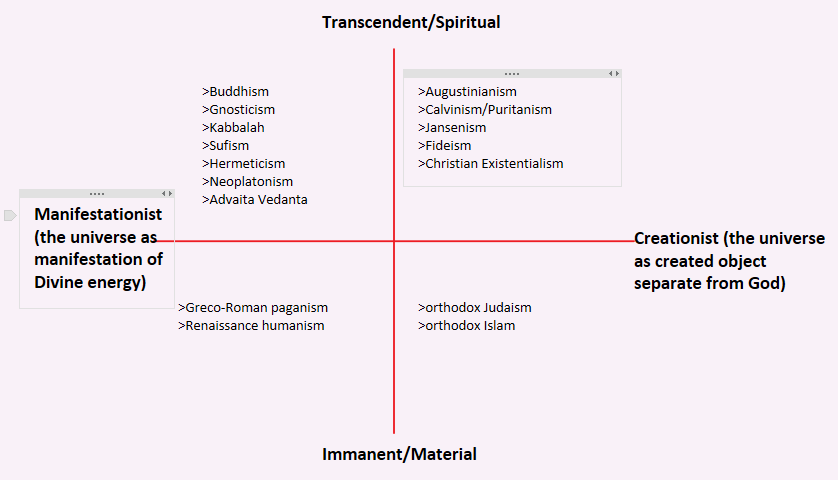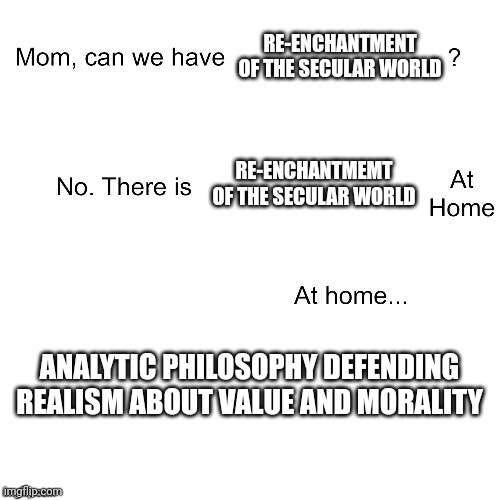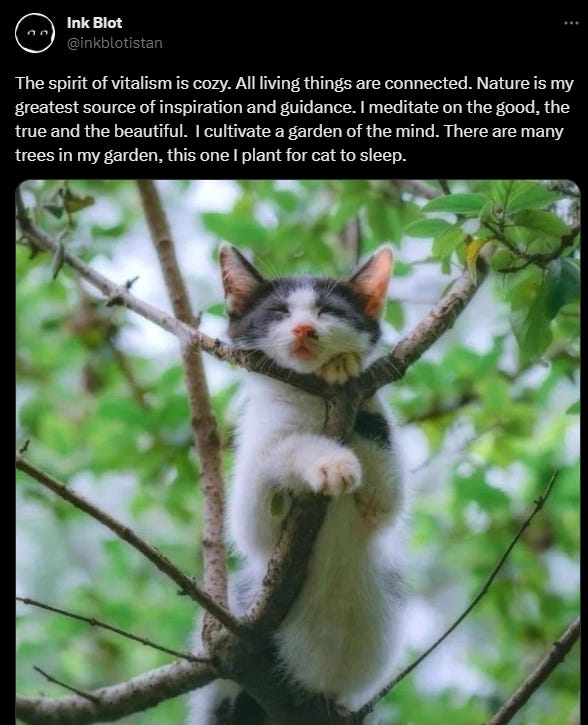Re-enchantment - some say it's LARP, some say you shouldn't actually believe that stuff. 3 takes on this:
Reddit Groyper on Twitter:
My main grievance with those who preach reenchantment is the constant calling a for suspension of judgement in a way that makes it clear they themselves have a voice (often representing social norms) in their head telling them what they're doing is ridiculous.
[account suspended since, link unavailable]
@jardinsecret888 on Twitter:
People will voluntarily wander into LARPGs, it’s what happens when you starve people’s souls with a materialist framework that precludes the transcendent and enervate their capacity for spiritual discernment
https://twitter.com/jardinsecret888/status/1567595908589654021
@taalumot on Twitter:
if your religion/pseudo-religion/de facto religion requires people to believe things, you are ngmi
The memes about 'revolt against the modern world' are two layered. The first layer is the ontology, in many memeplexes materialistic, the second layer is the meaning-world. Marx's writings on alienation deal with the latter while keeping materialistic ontology. Jordan Peterson and other Jungians refuse to talk about ontology in specific terms and focus on the meaning-world change. This post is about the drives in the first layer. Many people and literature protagonists are beset with the struggle of a reductive ontology being at odds with their need for meaning. Many angsty Millennial animations fall into this category.
There are many incentives to appear scientific, mainly social, explained through signalling theory.
Postsecularism is the place in society-space where public secularism is rejected and the Public / State embrace post-secular values, possibly returning to forms of religion or adapting new behaviors in a religious manner.
The duality of secularism - postsecularism as a social process has a mirror in the ontology layer - disenchantment and (re)enchantment. Of course that bleeds onto the normative, meaning layer.
I say total disenchantment is an impossible state to reach. I will talk how:
Animism is a stable element of the memetic landscape, recently mostly implicitly or as an undercurrent
Disenchantment is a disappearance of public spirituality grounded in Protestant mechanistic physics
Then I will examine existing approaches to re-enchantment. The main axis of the difference is what is put first, the enchantment or the materialistic memeplex. Some approaches add a sacred layer onto the materialistic stack and later try to remix it into a coherent whole, while others restructure that stack from the start, shifting the everyday perception.
1 Stability of the drive
I will prove the stability of the drive through enumeration of examples going into the past. Some seem to think America was full of good Christians and only in the 2000s been assaulted by godless neopagans. Some say this is a postmodern, hippie phenomenon, stuff like Gaia theory. Some say that the occultism of Crowley influenced Wicca and point out postmodernist tendencies already in Helena Blavatsky, and of gothic literature.
Some say: "but the time before the Enlightenment was a solid Christian time!" Yet there was the literary tradition of invoking deities, like Montaigne about Fortune, there were things like Italian 'old religion' , finally all the alchemists and even Sir Isaac Newton was an occultist. How far do we need to go back to find the pure variant? Descartes?
Catholicism, Judaism and Islam all contain references to many spirits, angels and holy figures. In Islam there are quite many angels, not to mention the Djinn, that in other religions would be called minor gods on the account of their power level, but the Neoplatonist influences redefined "God" as 3-omni (Omnipresent, Omniscient, Omnibenevolent) so that in the end only 1 thing can have that status.
Do we need to go even further back? Japanese Shinto and Chinese folk religion, finally the Buddhist pantheons of bodhisattvas are all firmly affirming the animism stance. There was an interpretation, a long time ago, that it is monotheism not paganism that was humanity's first religion. That was the German Ur-monotheismus theory, long since discarded.
This was but a brief overview of the case of the animist drive as a persistent feature of human experience and theological thought. Of course there were times when this subsided in the upper echelons, or when the leading celebrities-scholars had a strong conviction otherwise few talked about this.
I listed here mainly the more well-known cases, enough to scatter along the timeline, but there's a bigger argument and a better list than that. It's in a book by Brendan Myers, PhD (@Fellwater on Twitter), 'The Earth, the Gods and the Soul', that I reviewed here.
(De la connaissance de Dieu by Auguste Joseph Alphonse Gratry (1805 - 1872) French Catholic, priest, theologian, and philosopher.)
Many are saying this!
This idea being implanted in your minds, let's change one more paradigm.
2 Atheism and monotheism both tend to disenchantment
For many Christians, or religious people broadly a main distinction in the relation between individual religion and state is not whether the religion is anything in particular, but whether a person believes in an afterlife at all. Differences in theology can be reconcilable, or the other guys who are slightly wrong in the way of worship might get some punishment, but it's all better than denying the transcendental reality altogether - that is the mindset. A big example is John Locke who in his Letter Concerning Toleration explicitly excluded atheists from subjects to tolerance, saying that their rejection of the idea of eternal game theory (reward/punishment) makes them unfit to be citizens.
Hippies aren't that dissimilar from that, you're supposed to 'wake up' from the materialistic world to the higher realities, and the details are brushed aside, you're all oppressed drug users anyway. Yes, that's all just friend-enemy distinction. But it maps to a binary choice - either the material is all there is or some transcendent vision must be true.
That binary is false. The axis on which these 2 have the same coordinates is enchantment of this world. Both approaches deprecate this world and either accept it or talk about some other dimension. Now this rejection of enchantment in the world is what 'atheism' meant for the ancients. For them Christians were atheistic - rejecting the orthopractic worship of traditional deities, that all other people did. Of course many gods were local but everyone was expected to pay some respect to the public ones. There was nothing eternal about an individual making a sacrifice to a different god on some day. Jealousy between polytheist gods aren't mentioned in that sense. That is incomprehensible to a monotheist affirming immortality of the soul - that is seen as a betrayal.
Both atheism and monotheism reject the concept of 'entities in this world that you need to greatly respect and make some sacrifices to'.
In that view, monotheism and atheism are both sugary drinks with near-same flavor, like pepsi and cola.
What you need to see is the immanent-transcendent distinction as of ultimate importance. See this graphic. transcendental / imminent vs manifestations / creationism
https://twitter.com/saturnine_grace/status/1336378573448482822
This is quite clearly evident in 17th Century Anglo-Irish chemist and natural philosopher, Robert Boyle He
warns against the tendency of some natural philosophers or ‘physiologiers’ to give an excessive veneration to nature, to see nature as itself intelligent and og-like. Such a view causes philosophers to deny God. But the mechanical philosophy, precisely because of its emphasis on mechanism, finds no evidence of intelligence in nature itself… - Duddy, a history of Irish thought, pg 59
the original Boyle's 'A free enquiry into the vulgarly receiv'd notion of nature made in an essay address'd to a friend / by R.B., Fellow of the Royal Society.' is available here.
In our times the "vulgarly receiv'd notion of nature" is that which Boyle wanted - sterile, waiting for human action. (Yes, I disagree with Mises...) Kicking nature with a pitchfork is not a good idea…
Protestantism rejected the human drive towards animism and 'woo' swept in across many demographics where Catholics would practice prayers with saint intercession.
By now we established two facts, persistence of quite a primal drive towards enchantment and animism and the similarity between monotheism and atheism. If you're not convinced, comment before moving on. There is also a weak case (so far) for why actually being explicitly animist would be good. That will come later.
Before we move on, let's just guard against some objections: some pantheons do have a head god but that doesn't mean the others don't exist, and if 'atheism' means to you merely a lack of belief, and therefore of different category than positive religious belief, then substitute the 'postwar humanist progressivism'.
The question appears - what institutionalization and systemization attempts have happened to animism then? Why isn't it more widespread than it is?
3 Existing approaches
There is a lot of attempts, with varying degrees of success. Cults are hard to get right. I don't see any animist congregation / organization / memeplex to have been successful at scale for a long time. The main issues are scalability, maintaining direction and avoiding the LARP label. Different approaches are liked by different personality types.
3.1 Adding sparkles approach
Many 'woo' proponents have 'I trust the science' as a strong element of their identity.
That results in the process: we start with the'scientific worldview' - a set of facts about the physical world, scientific method, and their relation to each other.
Then we add a sprinkle of magic to make it sexier, the world more liveable. All physics works as before, just some new options appear. This could be quantum soul, reincarnation, karma, all conveniently unfalsifiable. Ontology of Star Wars, or Good place are good examples of this.
The belief-space is split between the empirical realm and the spiritual, the realms are treated in different discourses. But if we look at the old traditions, or many modern movements too, that are enchanted - they don't segment their belief - space thus. These worldviews are integrative, all encompassing. That is not an easy feat. Definitely Scientology is up to par in this regard. There the narration of humans is embedded in a larger cosmic narrative that at the same time leaves space for personal growth.
There are many smaller organizations like this, often fitting the pattern of 'charismatic leader makes it, gets influential on his death the sect splits again and again resulting in waning in popularity'. You might have heard of Fourth way - 20C attempt at reconciliation of doctrines.
The 'add sparkles' approach in failure mode is an abusive cult, multi-level marketing schema or just a fairytale for small children.
3.2 Deflationary approach
This approach is to treat objects you see everyday differently, too see a living creature in a tree you pass by on your way to work, and to treat its space as sacred. This is quite panentheistic and often more philosophically sophisticated than the other one.
The book I recently reviewed, Emma Restall Orr's "the Wakeful World"
Tends to lean on that side. A temporary spirit is sought in a harmony of voices cheering in a stadium, or losing individuality on a rave.
In the online discourse the most prominent school embracing the deflationary approach is the psychologist school of neopaganism, saying that magick works only on your mind, or that Gods are only archetypes.
Problems with this approach? re-enchantment of the secular world - analytic philosophy defending realism about value and morality
https://twitter.com/ErsatzDoctor/status/1657940773344788480
For someone seeking sparkles they'd feel disappointed and call this LARP. Neopagans have internal beefs over the archetypal thinkers being effectively atheists. What is more, the deflationary approach has a strong postmodern vibe to it, praising individual interpretation and resulting in quite a decentralized community, or rather 'structureless' and 'lacking in institutional power'.
If this is dry, wait until you see the argument from social consequences.
3.3 Argument from social consequences
This is quite interesting and inspiring from a scholarly perspective, but unlikely to excite fervor.
German philosopher Odo Marquard discussed monomyth vs polymyth resurrecting polytheistic thinking at a 1978 lecture In Praise of Polytheism The tl;dr of this is a case for religious pluralism and avoidance of certain fanaticism failure modes.
Further support for non-monotheistic thinking comes from the existentialist tradition, which mirrors in many ways the moral discussions of the ancients. What comes to mind the most is De Beauvoir's "ethics of ambiguity".
Finally we have the approach that the infamous e/acc falls into.
3.5 We are making the magic
The previously discussed 'deflationary approach' had quite a passive vibe to it. Relax, feel the wind, consider it sacred. Not much sacred, magical was seen in human work, technology. That is different in this approach, which is definitely deflationary as well. 'Technology is magic that works' is a soyjak cope, ot at least is often seen as such. Yet the 'doer-builder-technoptimism' is effectively this, but unlike soyjaks, it actively creates new things, participates in the process of creation.
This is the spirit present on TPOT. And it is glorious. It's so glorious I'm spending the whole next post talking about it.
https://twitter.com/Conaw/status/1606892916236251136
https://twitter.com/inkblotistan/status/1686256031909748736
Conclusion
As of yet I'm not describing a novel approach to these questions, merely analyzing existent answers. What will come next is an examination of the latest iteration - technoanimism in TPOT.
Of course that is not a completed system but unlike German Idealism completion is nearing. I will integrate TPOT metaphysics and ontology over the following weeks.
PS
I'd call this post "we have always been animist" but there's already been video on this, but it's relevant. It's some lecture on Harvard, here the original link and here the youtube clip:
Links to other parts:
rats and eaccs 1
1.1 https://doxometrist.substack.com/p/tpot-hermeticism-or-a-pagan-guide
1.2 https://doxometrist.substack.com/p/scenarios-of-the-near-future
making it 22.1 https://doxometrist.substack.com/p/tech-stack-for-anarchist-ai
2.2 https://doxometrist.substack.com/p/hiding-agi-from-the-regime
2.3 https://doxometrist.substack.com/p/the-unholy-seduction-of-open-source
2.4 https://doxometrist.substack.com/p/making-anarchist-llm
AI POV 3
3.1 https://doxometrist.substack.com/p/part-51-human-desires-why-cev-coherent
3.2 https://doxometrist.substack.com/p/you-wont-believe-these-9-dimensions
4 (techo)animist trends
4.1 https://doxometrist.substack.com/p/riding-the-re-enchantment-wave-animism
4.2 https://doxometrist.substack.com/p/part-7-tpot-is-technoanimist
5 pagan/acc https://doxometrist.substack.com/p/pagan/acc-manifesto









